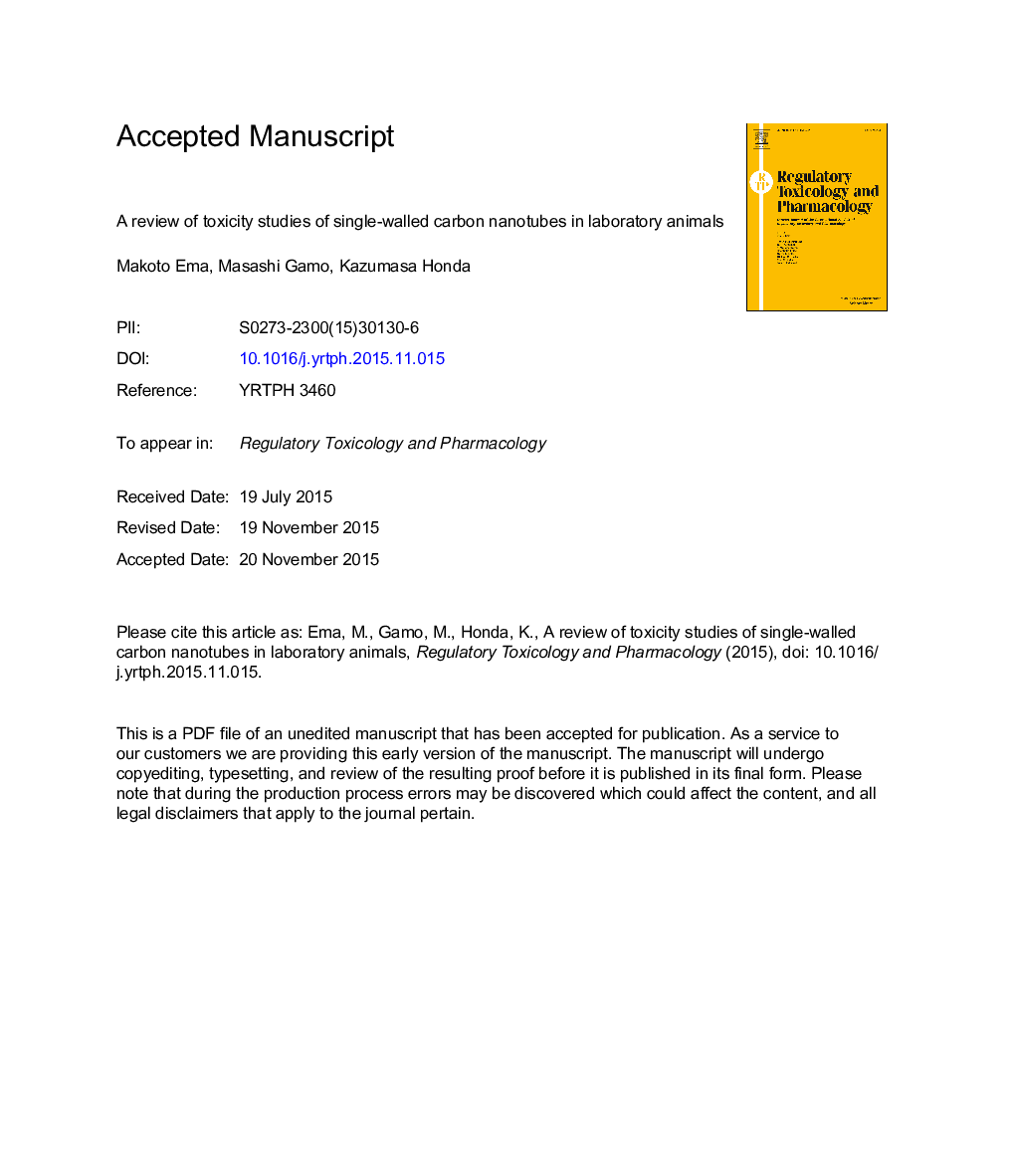| Article ID | Journal | Published Year | Pages | File Type |
|---|---|---|---|---|
| 5856078 | Regulatory Toxicology and Pharmacology | 2016 | 103 Pages |
Abstract
We summarized the findings of in vivo toxicity studies of single-walled carbon nanotubes (SWCNTs) in laboratory animals. The large majority addressed the pulmonary toxicity of SWCNTs in rodents. Inhalation, pharyngeal aspiration, and intratracheal instillation studies revealed that SWCNTs caused acute and chronic inflammation, granuloma formation, collagen deposition, fibrosis, and genotoxic effects in the lungs. Pulmonary toxicity of well-dispersed SWCNTs was more potent than less dispersed ones. Airway exposure to SWCNTs also induced cardiovascular diseases in mice. Oxidative stress was caused by the administration of SWCNTs. Injected SWCNTs were distributed throughout most of the organs including the brain, mainly retained in the lungs, liver, and spleen, and eliminated through the kidney and bile duct. Orally administered SWCNTs are suggested to be absorbed from the gastrointestinal tract to the blood circulation in mice and rats. Although no definitive study on the carcinogenicity of SWCNTs is available at present, evidence of carcinogenicity has not been reported in toxicity studies cited in this review. Overall, the available data provides initial information on SWCNT toxicity. To further clarify their toxicity and risk assessment, studies should be conducted using well-characterized SWCNTs, standard protocols, and the relevant route and doses of human exposure.
Keywords
DTPAMMPDeferoxaminePBSGGTMCP4-HNEMWCNTsCNTSMIPDFONMSSPCSSANADPHGSHACEAMSLPOALTOVAESARESMDC8-oxo-dGCNITGFDSPCNAGPDGFSAAPMNsMDSCMLNAT-IILVDPLLCSWCNTsDOTAT-AOCUltrashortMDATNFalveolar type IIENMsHiPcochicken egg albumintotal anti-oxidant capacity1,2-dipalmitoyl-sn-glycero-3-phosphocholine4-hydroxy-2-nonenal8-oxo-7,8-dihydro-2′-deoxyguanosineMPONPsROSγ-Glutamyl transferaseASTAspartate aminotransferaseAlanine aminotransferaseALPAlkaline phosphataseAngiotensin-converting enzymeInhalationinflammationendothelinoxideinterferonIFNinterleukinPAIplasminogen activator inhibitorBALFLeft ventricular developed pressuretransforming growth factorTransgenicIntratracheal instillationPurifiedOxidative stresstumor necrotic factorEMTDiethylenetriaminepentaacetic acidDiametergestational dayLungSODSAA, Serum amyloid ASerum Amyloid PSpecific surface areaEffective surface areaMyeloid-derived suppressor cellsSuperoxide dismutasecytokine-induced neutrophil chemoattractantReticuloendothelial systemSAPHeart rateLengthplatelet-derived growth factorPhosphate buffered salinelactate dehydrogenaseLDHpolymorphonuclear leukocytesmatrix metalloproteinasemalondialdehydeAlveolar macrophagesBronchoalveolar lavage fluidEngineered nanomaterialsMitochondriamyeloperoxidaseNanomaterialsNanotoxicologyNanoparticlesSingle-walled Carbon NanotubesMulti-walled carbon nanotubesCarbon nanotubesknockoutnicotinamide adenine dinucleotide phosphateheme oxygenaseVitamin Emonocyte chemotactic proteinmacrophage inflammatory proteinclara cell proteinsurfactant protein CC-reactive proteinCRPCINCCreatine kinaseEpithelial–mesenchymal transitionMediastinal lymph nodeGlutathioneReactive oxygen species
Related Topics
Life Sciences
Environmental Science
Health, Toxicology and Mutagenesis
Authors
Makoto Ema, Masashi Gamo, Kazumasa Honda,
